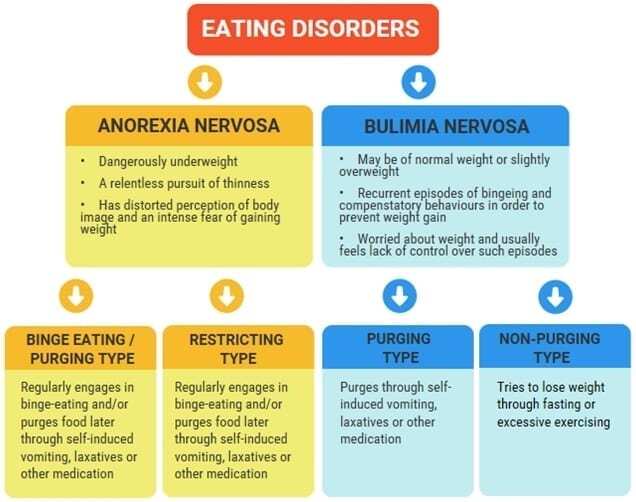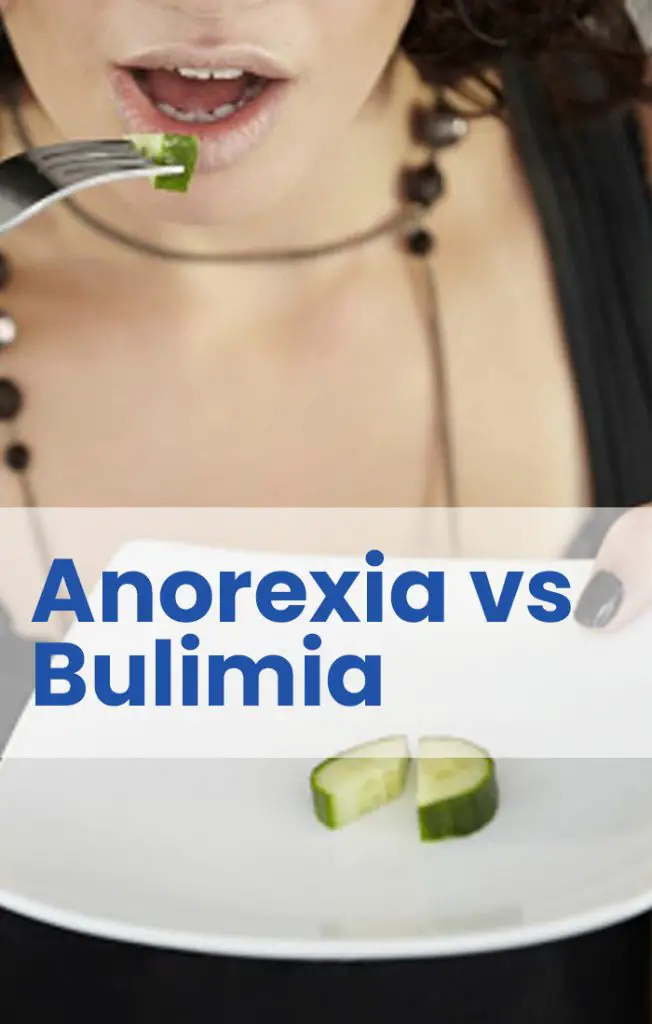Both anorexia and bulimia are eating disorders and therefore share many similar symptoms.
Their main difference is whether the eating disorder is caused by being too full, or being too hungry.
Keep reading to learn more about these two contrasting eating disorders and for the venn diagram down below.

However, there are also marked differences, and these differences are the primary focus on this article, which will cover:
- Big Picture Differences Between Anorexia And Bulimia
- Signs, Behaviors And Symptoms: Anorexia Versus Bulimia
- Similarities Between Anorexia And Bulimia
- What Causes Anorexia And Bulimia?
- How Anorexia And Bulimia Are Clinically Diagnosed
- Rates Of Mortality
If you would like to see a video where I discuss some of the above points, you can view this video:
Big Picture Differences Between Anorexia And Bulimia

Here are two simple ways of thinking about the anorexia and bulimia:
Anorexia – is where somebody habitually restricts their food intake to an extreme degree.
Bulimia – is where somebody habitually binge eats and then ‘purges’. A purge is most typically done by self-induced vomiting, but people with bulimia also purge by using laxatives and enemas.
The main difference between anorexia and bulimia is food intake. A person with anorexia rigidly avoids food; whereas a person with bulimia eats too much food and then tries to purge the food out of their system.
And while there are sub-types of Anorexia and Bulimia, in this article we stick with the primary differences between anorexia and bulimia. The reason I hold off from exploring the sub-type symptomogy is because with binge eating non-purging there is still considerable research that still needs to be done.
Signs, Behaviors And Symptoms: Anorexia Versus Bulimia
Anorexia Major Signs:
In addition to a severely restricted diet, people with anorexia oftentimes exercise to an extreme degree. For example, I met one woman who told me she would eat carrots for breakfast, celery for lunch, and protein powder for dinner and then run on a treadmill for 3 hours each day.
This type of restrictive eating can be deadly. Exercising this much without properly replenishing your body can lead to fainting, heart attacks and other symptoms, which is why an eating disorder meal plan can be helpful.
Anorexia Behaviors:
In addition to extreme exercise, a person with anorexia also will start to perform other behaviors, before their physical symptoms are visible. Some of these behaviors include:
- Not eating meals
- Lying about skipping meals or how much they ate
- Only eating low-calorie foods
- Exhibiting obsessive eating habits like cutting every food into precise pieces
- Making disparaging comments about their body
- Not wearing tight clothes because they think they are fat
- Avoiding social situations that involve food, like birthday parties or going out with friends
What drives a person with anorexia to be so rigid and restrictive towards themselves? Both the restrictive eating and excessive exercise stem from the person’s desire to have complete and total control over their body and food.
Oftentimes a person with anorexia has deep anxieties and they channel their anxieties into being perfectionistic towards food and exercise. For example, a person with anorexia may:
- Plan out precisely what time they will eat
- Measure out perfect portion sizes and know the precise number of calories
The motivations behind anorexia can be complex, and we will explore more of these motivations below. For now, all you need to know is that in every case the person has a highly distorted view of themselves. For example, someone may weigh 98 pounds and their ribcage might be visible. Yet this person to themselves might look in the mirror and think ‘I am horribly overweight.’
Losing weight then is seen as the only way to fix their body image and channel their anxiety. Whatever the reasons, these motivations lead to very real negative physical consequences.
Physical Symptoms Of Anorexia
- Dangerous weight loss
- Inability to sleep
- Lightheadedness
- Dehydration
- Exhaustion
- Thin, dying hair
- Feverish skin
- Extremely cold all the time
- Lack of menstruation
- Irregular heartbeat
Emotional Symptoms of Anorexia
- Low self-esteem
- Distorted body image
- Loneliness and social isolation
- Depression
- Anxiety
- Irritability, frustration
- Mood swings
- Fatigue
Bulimia Major Signs
People with bulimia have a similar obsession about food, but unlike people with anorexia, people with bulimia lose control around food.
This is the major difference between anorexia and bulimia: people with bulimia lose control around food and then compensate by purging, whereas people with anorexia maintain hyper-vigilant control over their food intake.
After losing control to a binge episode, a person with bulimia feels horribly guilty and shameful. They also often feel painfully bloated physically in their stomach. These feelings of guilt, shame and bloating motivate the desire to purge the food out.
Bulimia Behaviors
A person with bulimia can exhibit some of the following behaviors:
- Obsessing about their weight and appearance
- Eating far too much food and feeling bloated
- Going to the bathroom right after binge eating, or even after just eating a normal meal
- Exercising too much (similar to anorexia but different in food consumption)
- Restricting calories as a way of compensating after a binge (like anorexia, but at some point the restriction leads to a binge, whereas people with anorexia don’t binge often)
- Avoiding social situations where food is involved
Bulimia Physical Symptoms:
- Highly fluctuating weight swings with extreme amounts (like 5-20 pounds per week)
- Dry parched lips
- Bloodshot eyes
- Calluses or sores on knuckles from induced vomiting
- Eroding tooth enamel
- Swollen throat
Bulimia Emotional Symptoms:
- Low self-esteem
- Distorted body image
- Loneliness and social isolation
- Depression
- Anxiety
- Irritability, frustration
- Mood swings
- Fatigue
Notice how the emotional symptoms of anorexia are the same as the emotional symptoms of bulimia? Both anorexia and bulimia are eating disorders and have many similarities.
Similarities Between Anorexia And Bulimia
Honestly, sometimes I feel that both anorexia and bulimia are the same disease.
I say this because at the eating disorder center where I work as a Recovery Counselor, I see some people with anorexia, some other people with bulimia, and still others with binge eating disorder.
What I’ve observed is that both anorexic and bulimics are coming from a place where they have incredibly, twisted and distorted thoughts about their self-worth and their body.
They beat the hell out of themselves. They get trapped in their thoughts. Harsh, demanding voices are heard internally, constantly and all the time. They get anxious.
To manage these negative mental thoughts and emotions, both bulimics and anorexics turn to food.
Anorexics channel their anxiety and try to prevent their negative thoughts by being overly controlling towards food, whereas bulimics tend to use food to block out their feelings by overconsuming and then purging afterwards. While different in outward manifestation, the underlying motivation is very similar.
Here are some other similarities:
- Body dissatisfaction
- Low self-esteem and self-worth
- Desire to change their body and their weight
- Depression
- Anxiety
- Malnutrition
- Impacted heavily by media images
- Need help to heal
Overall, I believe the similarities between anorexia and bulimia are greater than their differences.
Now that you have a greater understanding of the differences and similarities between anorexia and bulimia, let’s examine the causes behind these eating disorders.
What Causes Anorexia And Bulimia?
Unfortunately, we don’t know precisely what makes anorexia or bulimia develop. No doubt some combination of genetic, individual circumstances and cultural conditioning are the forces behind these eating disorders. These include:
- Genetic predisposition to eating disorders (according to, for example, a 2011 study)
- Past experience with trauma
- Past emotional struggles with anxiety and depression
- Societal pressures. For example, there are higher rates of eating disorders in gymnastics, wrestling and ice skating. In these social groups, disordered eating is encouraged. I can attest to losing weight when I was a wrestler in high school and then binge eating after tournaments only to gain the weight back. I didn’t know I had a problem because literally the entire wrestling team would do the same behaviors!
Anorexia And Bulimia Specific Causes
There are a few risk factors specific to developing anorexia and bulimia. Some common risk factors include:
- Obsessive, rigid tendencies
- Coming from an environment that overly fixates on and values thinness
- Having a family member with anorexia
- Going through puberty at very young age
- Concerned about obesity and weight early in life
- Having a family member with bulimia
Now that you know the differences, similarities and factors of anorexia and bulimia, let’s examine how you actually diagnose these eating disorders from a clinical perspective.
How Anorexia And Bulimia Are Clinically Diagnosed
For starters, diagnosis is easier said than done.
People with anorexia and bulimia are notorious for hiding their symptoms. Even if someone who is struggling knows they have a problem with food, often this person will avoid getting help because they see their problem as too embarrassing.
It’s very important that a friend, or family member can give support and encouragement to someone struggling with anorexia or bulimia. When a person with anorexia or bulimia is under the age of 18, their family member will have to accompany them to the hospital or therapist.
Once at the doctor’s office or with a therapist, the expert will make a diagnosis based on the person’s symptoms.
Clinical Diagnosis
These are the different criteria used by mental health professionals and doctors to clinically diagnose anorexia or bulimia.
Anorexia:
- Restricted food intake to maintain body weight lower than average for your age, height and built
- Intense fear of gaining weight
- Self-worth is derived from a thin body image
Bulimia:
- Recurring episodes of binge eating
- Recurring behaviors of compensation which include purging and excessive exercise
- Both binge eating and compensatory behavior occurring for 1 time per week for past 3 months
- Self-worth derived from distorted body image
Rates Of Mortality
Mortality rate refers to how often people who have either anorexia or bulimia die.
It’s very important to realize that these diseases are deadly. Unfortunately, the mortality rate of both anorexia and bulimia is high because of poor physical health and suicide.
Anorexia mortality rate = approximately 5%
Bulimia mortality rate = approximately 2%
And while this other does not specifically examine treatment approaches, here is an excellent article by the Mayo Clinic on treatment options for anorexia and bulimia.
Conclusion
The main difference between anorexia and bulimia is food intake and compensation. However, there are many similar symptoms, especially in the emotional realm. Both anorexia and bulimia are eating disorders and share much in common.
While exact causes are unknown, we do know there is some combination of genetic and environmental factors that cause the disorders. Unfortunately, these disorders due have a high mortality rate, but there are effective treatment options available if the person gets the help they need.



